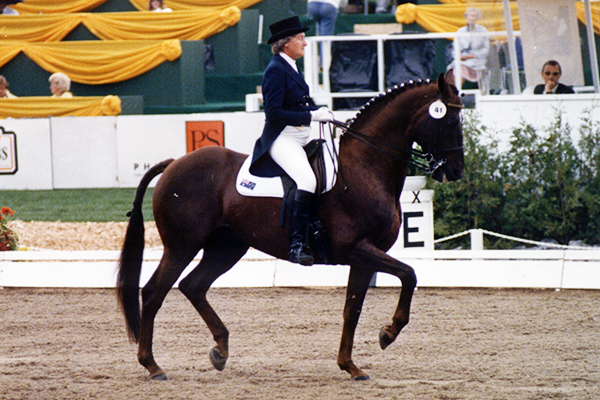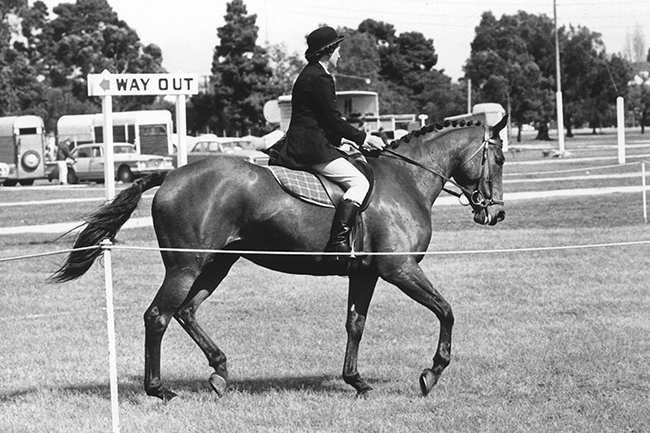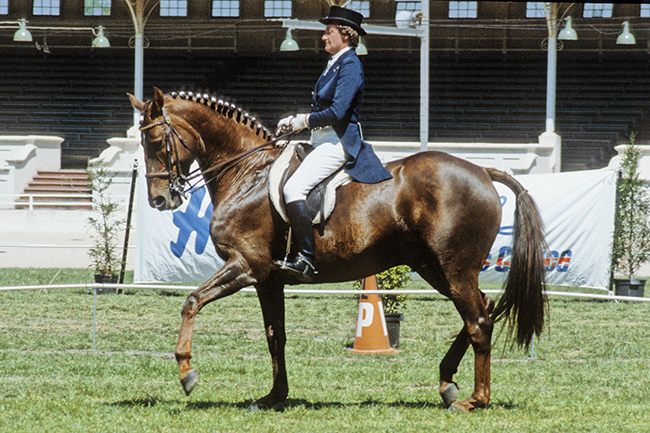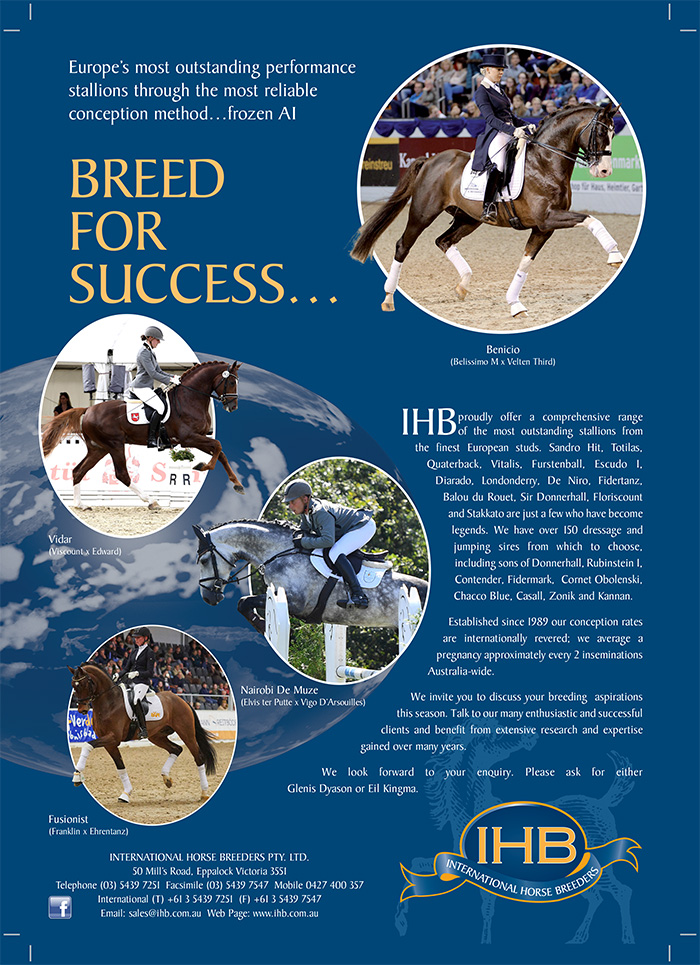 I’ll never forget the first time I saw Erica Taylor and Crown Law. It was back in the early 80’s when Judy Mackay organized at clinic in Victoria with Hubert Eichinger from the Spanish Riding School. The little Thoroughbred stallion meandered casually in the direction of the Indoor School, and before I could think – ‘Is that all there is?’ – he started to move, and move with such purity of rhythm that it took your breath away.
I’ll never forget the first time I saw Erica Taylor and Crown Law. It was back in the early 80’s when Judy Mackay organized at clinic in Victoria with Hubert Eichinger from the Spanish Riding School. The little Thoroughbred stallion meandered casually in the direction of the Indoor School, and before I could think – ‘Is that all there is?’ – he started to move, and move with such purity of rhythm that it took your breath away.
Later, Erica and ‘William’ blossomed under the tutelage of Wolfgang Holzel, with Erica responding perfectly to Wolfgang’s gentle exposition of the classical principles, and the pair starred at both the World Championships in Canada in 1986 and the Seoul Olympic Games in 1988.
There certainly cannot be a more worthy recipient of the inaugural Lindy Wright Memorial Award, and for the award’s night, one of the members of the steering committee, Liz Duncan, prepared a tribute to Erica.
Let Liz tell the tale:
“I first met Erica in the latter part of the 1970s when she was competing in FEI dressage on Crown Prince. Soon after, Crown Law was to emerge as a very talented horse. However, the scene was set many years before.”
“Erica grew up on a farming property in the lower Flinder’s Ranges. Horses were a core part of her family life, with her grazier father also training and breeding trotters. Erica told me she that from the age of seven she used to ride a pony to and from school each day. Later her father gave her a chestnut foal that he did not want to keep as a trotter — this was “Goldie” who as Silverado. became her first competitive partner in all sorts of horse events — hacking, novelties, point-to-point, jumping.”
“When Erica moved to Adelaide in the 1950s she met Tom Roberts and had her first taste of dressage lessons, and the rest is history. With ‘Robbie’ as her coach and mentor, Erica trained Beau Rae to FEI level. Next she found Crown Prince, another chestnut who was very trainable and helped her develop her love of dressage.”
“All this experience set the scene for the arrival of Crown Law, known as William to his friends. It is a well-known story that in 1972 Erica and her husband Les were given a Thoroughbred mare as part payment for a float from Les’s business. The mare was in foal by accident, but as the breeding lines had quality and she was a nice type, they decided to wait and see what the foal was like before deciding what to do next. A chestnut colt was born and it quickly became apparent that William was very talented and had a wonderful temperament, so he became part of the family.”
Erica and Crown Law
“Erica has had many career highlights but of particular significance she is the only South Australian to have represented Australia in Dressage at Olympic Games competition, and was only the second Australian rider to represent our country in dressage. In 1988 she rode Crown Law at the Olympic Games in Seoul and together they represented our country well, with creditable scores against world class competition. At these Games Nicole Uphoff won the gold medal on Rembrandt. I read from the competition scores that Erica and Crown Law achieved 1245 points which put her two places ahead of a young Anky van Grunsven! They also represented Australia at the World Equestrian Games in 1986 in Canada.”
story continues below the advertisement
“In the competition arena Erica’s tests were always characterised by relaxation, an excellent rhythm and beautiful harmony. She combined good horsemanship and the requirements of dressage to show how training with a focus on the basics can produce work of a high degree of difficulty and maintain a happy, healthy horse.”
Erica and Cascade at Adelaide Royal
“I asked Erica about who had influenced her dressage training. She said it was Tom Roberts who had had an enormous influence in her early days. He taught her how to analyse the horse’s mind and understand training from her horse’s perspective. This was important to establish the confidence and quiet obedience seen in her horses. With this help and her own innate sense of rhythm and what felt right, Erica was able to achieve a relatively high degree of success.”
“She says that the next big breakthrough was her training with Wolfgang Holzel. At schools with Dr Holzel, Erica learnt more about the importance of the exercises to improve the suppleness and elasticity of the horse’s back. This improved the quality of all Crown Law’s work but especially gave him the edge in the passage/piaffe work which reached a very high standard. One of my memories of Erica’s tests is that the tempi flying changes were always 100% correct!”
“I was keen to find out more about Erica’s approach to training and competition. She told me that she believes that competition can be very stressful to a horse and therefore it is extremely important not to introduce competition before he has had adequate training at home to become confident in his work. Erica would break in horses as two-year-olds, but then give them at least two years of more training and experience at home before taking them out as a four year old at the earliest.”
“She stressed that correct conformation, especially in the hindquarters, is extremely important to allow the horse to work with relative ease. Then, to work through various problems, an understanding of the horse’s mind is essential. Erica reminisced that William was the perfect horse and never had any problems. He was extremely intelligent, was very relaxed, had a great natural willingness and never needed a whip or spurs and always found dressage exercises easy.”
“In the years Erica trained and competed in dressage she won numerous classes in South Australian and Australian competition. It is worth remembering that although Crown Law was the most famous of Erica’s horses, she won 20 Australian championships at various levels on five different horses that she had bred and trained herself. Today, Erica is still an active member of our dressage community, contributing through her work as a judge, mentor, selector and committee member.”
“I think that with successful sportsmen and women, it is always fascinating to learn more about the person outside their sport. A major part of Erica’s life, especially in her younger days, has been her talent for music. In the 1960s she was known as Ricky Jones, and played the guitar and was a singer of both Country and Western and of Pop music. One year she won the musical competition “Australian Amateur Hour” – was that yesterday’s equivalent of Australian Idol? Later she had a recording contract with the Philips label.”
“Throughout her riding career Erica received and appreciated the total support of her husband Les. They have been married now for 42 years and have shared their life and business at their property at Waterloo Corner. It is a different time now, as Les has had two strokes in recent years and now needs full-time nursing care. Erica’s days are mainly devoted to helping care for Les.”
“During our conversation Erica was proud to say that the best compliment she had ever received was from Tom Roberts. He said to her “Erica, your horses always look happy!” A fitting tribute to the quality of a great South Australian and horsewoman!”
story continues below the advertisement

Liz Duncan interviews Erica Taylor
What philosophy guided your training?
“I am a believer in the KISS principle! Keep It Simple, stupid! It is important to ride with a feel for what is happening on the horse. I think too many riders want to over analyse the foot falls and things, and don’t develop feel. Lessons can’t give a rider ‘feel’ although it is something that can improve. However it is also important to have someone on the ground to watch over the training and make sure it is correct. For example crookedness is something that can creep up on you and you need some-one to check that the horse is straight.”
“I often think about the training scale and how it is presented by coaches and in judges’ clinics. It is important that people think about the training scale as dressage is very much a thinking sport. One question I have is whether Contact should come higher up the scale? I see it that you need a contact to help create rhythm and suppleness and to feel the horse on the end of the rein. This is of course not a heavy contact or pulling, but enough to feel a connection.”
Has your training in music influenced the way you ride and the rhythm you establish in a horse?
“It has possibly made a difference in that learning the piano and guitar made a regular beat second nature to me. Rhythm on the horse comes back to allowing the swing of the horse’s back. An important part of it is the horse’s natural rhythm. I often see riders who tend to over-ride their horses and have them too fast, while trying to get activity. This is not impulsion and the horse actually loses its swing and natural rhythm.”
What do you think of the direction that modern-day dressage is going?
“I think it is good that dressage is moving away from allowing the horse with a short, tight neck to be acceptable. There is a greater appreciation of the need for the back to swing and for the horse to be loose and supple. Also, there is more knowledge and better training available, especially for young riders. To be successful it is necessary for riders to have good material but also the right training.”
“At the international level, I think that horses are getting to Grand Prix very quickly. This might be right for the very gifted horses, but it lifts the benchmark for what can be achieved by a relatively early age. When other riders see what these gifted horses achieve at a young age they can think this is normal. There is then the risk that some horses can be ‘pressure-cooked’ in their training. The time it takes to reach Grand Prix is as long as it takes! It is unusual for a horse to find everything easy. Most horses have some areas that are their talent but other movements that need extra time and work to develop and improve.”
“From what I have seen in the media, Moorlands Tortilas appears to be an example of a very talented horse, short coupled, strong and with that extra “sparkle”. He appears to be in the right hands in that he is sensitively ridden and allowed to perform well.”
This article first appeared in the October 2010 issue of THM.


Erica is one of the best ever! A view also shared by George Morris. And she was also a great room mate at the Seoul Olympics!
My idol growing up!!! I never saw them compete and if anyone out there has footage I’d be very happy to view.
There must be many great archived articles from your magazines early years. When will they come online? Please Chris and Roz
This amazing lady was definitely a significant influence on me . I remember being so excited to come 2nd to her at a SA State Championships, after she came back from the Olympics….such an honour to be in the same competition, and as the article states, the stand out memory for me was that incredible rythem – never hurried, and oh so light!! She literally floated !
Erica was amazing and I greatly admire her achievements. To add to her list of achievements I believe she did the following
She was the test rider for the eventing dressage when the WEG eventing was held at Gawler SA. Test riders were used in those days for the judges to get their eye in.
I also think she made the Grand Prix Special at the WEG in Canada which was a massive achievement as at that stage they only took the top 12 qualifiers from the Grand Prix.